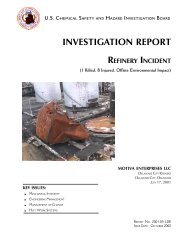CTA Report, Draft 1, ISP Review - US Chemical Safety and Hazard ...
CTA Report, Draft 1, ISP Review - US Chemical Safety and Hazard ...
CTA Report, Draft 1, ISP Review - US Chemical Safety and Hazard ...
You also want an ePaper? Increase the reach of your titles
YUMPU automatically turns print PDFs into web optimized ePapers that Google loves.
Executive Summary<br />
A February 20, 2003, dust explosion at the <strong>CTA</strong> Acoustics, Inc. (<strong>CTA</strong>) facility in Corbin, Kentucky,<br />
killed seven <strong>and</strong> injured 37 workers. This incident caused extensive damage to the production area of the<br />
302,000-square-foot plant. Nearby homes <strong>and</strong> an elementary school were evacuated, <strong>and</strong> a 12-mile<br />
section of Interstate 75 was closed. The largest <strong>CTA</strong> customer, Ford Motor Company, temporarily<br />
suspended operations at four automobile assembly plants because <strong>CTA</strong> had produced acoustic insulation<br />
products for those plants, as well as for other industrial <strong>and</strong> automotive clients.<br />
In investigating this incident, the U.S. <strong>Chemical</strong> <strong>Safety</strong> <strong>and</strong> <strong>Hazard</strong> Investigation Board (CSB)<br />
determined that combustible phenolic resin dust that had accumulated throughout the facility fueled the<br />
explosion.<br />
The investigation identified the following root causes for the February 20 incident:<br />
• <strong>CTA</strong> management did not implement effective measures to prevent combustible dust<br />
explosions.<br />
• The <strong>CTA</strong> cleaning <strong>and</strong> maintenance procedures for production lines did not prevent the<br />
accumulation of unsafe levels of combustible dust on elevated flat surfaces.<br />
• The <strong>CTA</strong> incident investigation program did not ensure that all oven fires were investigated<br />
<strong>and</strong> that underlying causes were identified <strong>and</strong> resolved.<br />
• The Borden <strong>Chemical</strong> product stewardship program did not explicitly convey to <strong>CTA</strong> the<br />
explosive hazards of phenolic resins.<br />
• The original building design <strong>and</strong> subsequent building modifications did not effectively<br />
address the fire <strong>and</strong> explosion hazards associated with combustible dusts.<br />
11









